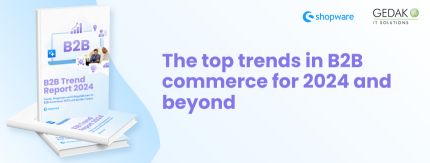
Are you digitally transforming to meet the ‘consumerization’ of the B2B buyer?
What makes B2B commerce different? We can talk about budgets, buyer committees, and complex decision journeys but the bottom line is, B2B buyers share many similarities with general consumers – including differentiated generational expectations.
B2B buyers are looking for personalization, convenience, quality, and value. They want to see their needs met in whatever channel they choose to interact, expecting product and communication innovation. In fact, the growing ‘consumerization’ of the B2B buyer is possibly the biggest shift in B2B commerce in a generation.
And generational demographics are important. Our new B2B report about trends, predictions, and key drivers for success in B2B Commerce 2024 and beyond dives into what really matters to B2B buyers and how digitization will help B2B commerce brands adapt to new needs. Below are some of the highlighted trends.
B2B: The next generation
One of the biggest shifts is the changing demographic of the average B2B buyer. As of 2023, 65% of B2B buyers are between the ages of 18 and 40, i.e. millennials and Gen Z. [1] This is important because how these two generations approach the world of work is markedly different to the generations that precede them.
Purpose-driven with a strong work ethic but equally strong personal life boundaries, ‘B2B: The Next Generation’ are heavily influenced by the tools and services they experience in their ‘consumer’ lives. Expectations are mobile-first, real-time, and highly social. Even TikTok is getting a slice of the action, where brands such as Sage accounting and Grammarly can reach some of its 885m-strong global audience with regular posts.
More mental availability
A shift in B2B commerce mentality is beginning. The sales process has often been driven by a short-term sales agenda when the complex B2B buyer journey is best served by a mix of both long- and short-term demand generation/demand capture activities. One fundamental fact explains why this is important: a majority of B2B buyers today will not become customers.
LinkedIn’s B2B Institute recently revealed that 95% of B2B buyers are simply not in market at any given time. They’ve either already bought or are in the middle of using existing systems and it may be some time before they’re ready to consider refreshing or purchasing. But businesses must target this group to build essential saliency, or mental availability, so their brand is front of mind when the opportune moment comes. [2]
Practical personalization
Given that the average B2B buyer is not normally a single person but a buying committee made up of people with different pressures, priorities, and personalities, it can be difficult to personalize messaging. However, practical personalization can target the channels and levers that might appeal to each cohort in a specific way to increase their interest.
Pricing is one of these levers. Price visibility is the leading factor that can nudge a prospective client towards being likely to buy (71%), versus free trials (70%) or customer reviews (35%), says one set of research. [3]
Being willing to be flexible on pricing is key – Gartner says that more than two-fifths of businesses (41%) find pricing mismatch with expectations the biggest dealbreaker. [4]

Naturally, data will be behind personalization at scale, whether in optimizing pricing, content or other strategies, and increased digitization of the B2B buyer experience will boost companies’ capabilities.
However, there are challenges on the horizon in data gathering, not least cookie deprecation which limits digital insights. B2B commerce brands will need to work harder than ever at gathering first-party data to expand their marketing and product development potential.
Digital evolution and direct to customer
Digitization of touchpoints in the buying journey has become a critical part of the customer experience. Buyers are increasingly mobile-first and move seamlessly between online and offline channels. B2B commerce brands must make sure they have the digital tools at their disposal to be able to serve these needs, not just today but in the future.
This means agility when it comes to strategy (not just executing short-term tactical shifts) and agility when it comes to technology. We see that 65% of B2B buyers want to self-navigate the purchase process today, using digital channels, chatbots, and content. [5] In some cases, they want to bypass the sales funnel altogether, taking a much more direct-to-customer approach. As conversational and generative artificial intelligence (AI) tools take hold, expectations will change again.
B2B commerce brands don’t want to have to completely reconfigure their tech stacks on a yearly basis, so making use of composable commerce elements, which are low or no-code solutions needing little IT support, will be key to futureproofing. Futureproof doesn’t mean predicting the future, rather being ready for whatever it’s going to throw at you.
Get the knowledge and gain a competitive edge by downloading the B2B trends report
Together with our partner GEDAK, we have created the B2B Trend Report for 2024 and beyond. In this blog post, you've received just a few insights from this report on trends, forecasts, and success factors in B2B commerce. Therefore, it's worth taking a look at the full range of topics covered in the report.
Download the full report completely free of charge
Covering personalization, pricing, channel optimization, and composable commerce, the report gives valuable insights into today’s B2B customer and explains how companies can make the most of technology, including cloud, AI, and the internet of things (IoT) to meet raised customer expectations.
[1] https://www.insiderintelligence.com/content/5-predictions-b2b-marketing-2023
[2] https://www.marketingweek.com/linkedin-b2b-institute-advertising-memorable-clickable/
[3] https://www.forbes.com/sites/garydrenik/2022/12/13/what-significant-shifts-in-b2b-buyer-behavior-means-for-2023/?sh=61d3bd661c43
[4] https://www.gartner.com/en/digital-markets/insights/how-the-b2b-purchase-journey-is-evolving
[5] https://www.gartner.com/en/newsroom/press-releases/2022-06-22-gartner-sales-survey-finbds-b2b-buyers-prefer-ordering-paying-through--digital-commerce











